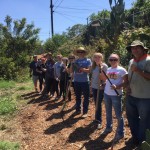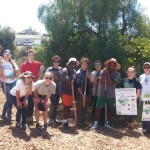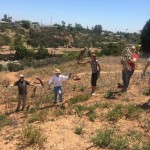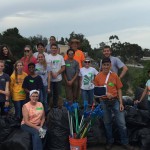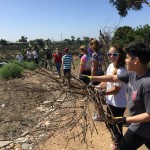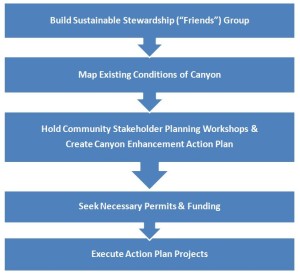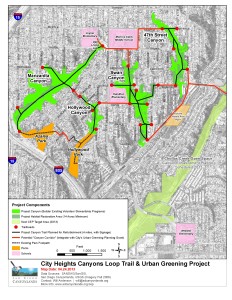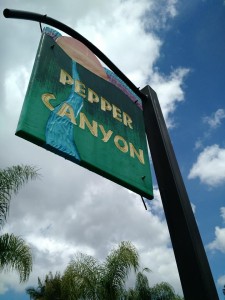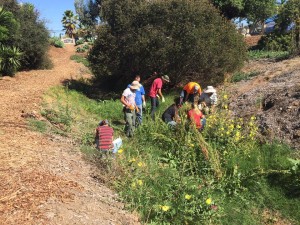By Freddy Arthur and Eric Bowlby
Field Supervisor and Executive Director at San Diego Canyonlands
This summer, San Diego Canyonlands (SDCL) and the City Heights Community in San Diego, CA, were blessed with the tremendous energy of over 300 youth (average age 14) and adult volunteers from Sierra Service Project (SSP). With their hard work spread out over eleven different urban canyon sites, and with 20+ volunteer days, this contribution of over 1500 service hours will have a lasting benefit for the underserved community of City Heights. Projects in five urban canyons (Auburn Creek, Manzanita, Hollywood, Swan, and Olivia Canyons) included improvements to the park trail system and the restoration of San Diego’s unique endangered, wildlife habitats.
When I received the call in February from Rick Eaton, Executive Director of Sierra Service Project, and he informed me that he had an army of volunteers coming to City Heights this summer, it reached a higher level of the term “godsend” indeed. SDCL had just finished planting about 5500 native plants, scattered in over 40 separate sites throughout four degraded urban canyons. Not only did we have the challenge of helping these seedlings survive their first summer with routine watering, we also had to prepare dozens of degraded areas for planting about 4000 more this fall/winter. Knock-knock, Sierra Service Project is coming to help!!
When I received the call in February from Rick Eaton, Executive Director of Sierra Service Project, and he informed me that he had an army of volunteers coming to City Heights this summer, it reached a higher level of the term “godsend” indeed.
The community of City Heights is one of the most ethnically diverse communities in the nation and it harbors thousands of refugees including Somalis that left Somalia in the middle of a deadly Civil War. Unfortunately, City Heights is also the most underserved community in San Diego in terms of parks and access to open space. Along with our partners and groups like SSP, SD Canyonlands has been working to help local residents rehabilitate over 180 acres of neglected open space in four canyons and along two creeks in City Heights, transforming them from dangerous, degraded open spaces, into a cherished community asset with new recreational nature trails, and opportunities for use as “nature classrooms” for urban youth.
With the kind of help we received this summer from SSP, we are on target to establish a unique, 5-mile, multi-canyon trail system and restore over 30 acres of habitat within the next few years. In addition to watering our native plantings in the middle of a drought, one of the key components that SSP helped with was establishing this exciting new trail system, including the links between the canyons across the urban landscape.
When we improve the streets that link our canyons together we call them “canyon corridors” or affectionately “butterfly corridors” (see above image). With SD Canyonlands’ guidance and resources from donors and grantors, and volunteer muscle like SSP delivered this summer, we have made great progress embellishing these “butterfly corridors” with improved pathways, native plant landscaping, murals, signage, and pocket parks. The birds and butterflies, attracted by the native plantings, will literally travel through the urban neighborhoods connected by these enhanced streetscapes. SD Canyonlands will also promote “Meetup” groups and jogging clubs to increase the recreational uses of these canyons once the system is built.
We are so excited that SSP will be joining again next year to continue helping us make this exciting vision unfold within a densely populated urban community that needs it the most.
Here is a brief summary of the projects where SSP volunteers worked and what they accomplished:
Manzanita Canyon
- 39th St trail UG Project – 33 youths and 13 adult volunteers worked here for 3 days removing invasive species and illegally dumped trash and debris from this area in preparation for the construction of a new trail segment to connect more neighborhoods with Azalea Park and Manzanita Canyon’s hiking paths.
- Central Ave at Manzanita Canyon – 10 youth and 5 adult volunteers spent one day here removing highly invasive plant species and a very large quantity of illegally dumped debris adjacent to an important wildlife restoration area.
Auburn Creek – In one day, 12 youth and 3 adult volunteers removed invasive plant species and mulched newly restored creek habitat areas adjacent to a heavily used urban trail that connects several neighborhoods to each other and to the natural environment.
Pepper Canyon – Over 3 days, 34 youth and 13 adult volunteers removed invasive species from our habitat restoration area, watered our new native plantings. Using weed-suppressing mulch, a 250’ segment of trail was widened and improved connecting Hollywood Canyon to Manzanita Canyon between two surface streets.
47th St Canyon – Over 3 days, 31 youth and 16 adult volunteers removed invasive plant species from a proposed site of a new trail segment and widened and improved with mulch 250’ of access path to this and adjacent habitat restoration areas.
Hollywood Canyon – Over 4 days , 44 youth and 16 adult volunteers removed invasive plant species, trash and debris from Pepper Dr. trailhead and Olive and Columbine TH & restoration areas, then widened and improved 250’ of entry trails with weed suppressing, heavy mulch.
Swan Canyon – Over 6 days, 74 youth and 22 adult volunteers:
- Maple St Trail Head – 2 days – SSP’s youngest two groups removed a 40 yard dumpster’s worth of tumbleweed and other invasive species, trash and debris from 2 different restoration areas, and from an important proposed trail segment location at south Swan Canyon.
- Highland Ave Trail – 3 days – SSP volunteers removed invasive plants, trash and debris from North Swan canyon restoration areas, mulched a new trail head staging area with 150’ of entry trail.
- Quince St at 46th – 1 day – volunteers removed invasive plant species, trash and debris from this Trail Head and trail surrounds as well as mulching 125’ of entry trail.
Editor’s note: Thank you to the over 300 volunteers who served with San Diego Canyonlands through our San Diego site this summer! We are very excited to be returning to San Diego during the 2016 summer.


